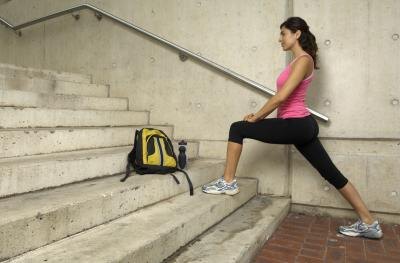
The groin area is composed of muscles known as the adductors. These consist of the adductor brevis, longus and magnus, in addition to the pectineus and gracilis. A groin strain takes place when the adductor muscle fibers tear from overtraining or exercising beyond your capacity. The end result is pain, stiffness and weakness on the inner thigh area. By taking precautionary and corrective measures, you can reduce the incidence of this type of injury.
Dynamic Warmup
Walking into an exercise session without a thorough warmup is a good way to injure your groin. When your muscles are tight, they are more apt to suffer a strain. The best way to avoid this is by doing dynamic stretches. The word "dynamic" means "in motion." By doing a dynamic warmup before your workouts, you will acclimate your body to exercising movements and reduce the chance of injury. Include dynamic stretches like forward and sideways leg swings, reverse lunges, high knees, alternating toe touches and forward bends. Five minutes of dynamic stretching is sufficient.
Starting Gradually
After doing a dynamic warmup, you may be tempted to jump right into your workout full steam ahead. Although you might be loosened up, this can still cause a groin injury. A better approach is to start out slow and gradually increase your intensity, especially with running and exercise that involves explosive movements. Treat this as a secondary warmup and spend five to 10 minutes gradually increasing your pace. This will also slowly raise your core body temperature and supply blood to your muscles.
Adductor Exercises
Weak adductors have a greater chance of suffering a strain than strong ones. The act of adduction takes place when you move your thighs inward. By doing exercises that involve this movement, you will strengthen your adductors and decrease your odds of getting a strain. A ball squeeze is a good example of an adductor exercise. Perform this from a face-up position on the floor with a medicine ball. Pinch the ball between your thighs with your knees bent and feet flat on the floor, and squeeze it forcefully. Hold for five to 10 seconds, slowly release and repeat for the desired number of repetitions. This is called a static, or isometric, exercise which involves no continuous movement. You also have the option of doing a ball squeeze with your legs fully extended and the ball between your feet.
Post-Workout Stretching
Stretching after your workouts is equally as important as stretching beforehand. When you are done exercising, your muscles are loose and in a lengthened state. By doing static stretching, you will keep your muscles and connective tissue flexible and reduce the risk of straining your groin with your next workout. Unlike dynamic stretches, static stretches are held for an extended period of time. A butterfly stretch is a common stretch used for the groin. Perform this from a seated position on the floor with your feet placed sole to sole, your knees bent and opening away from each other and your hands clasped around the tops of your feet. Position your elbows on the inside of your thighs and slowly pull your torso down towards your feet until you feel a stretch in your groin. Press lightly into the inside of your thighs with your elbows and reach your knees toward the floor. Hold the position for 20 to 30 seconds and slowly release.





No comments:
Post a Comment